


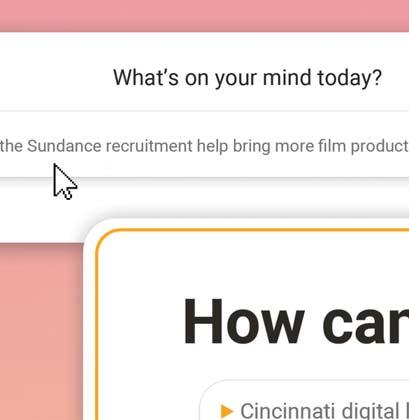




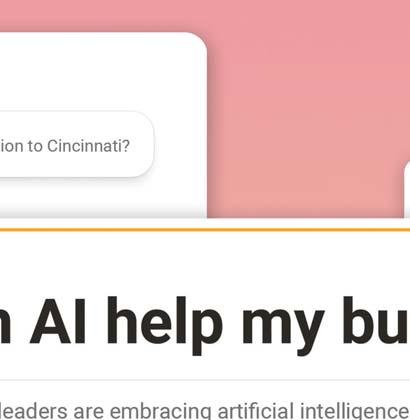



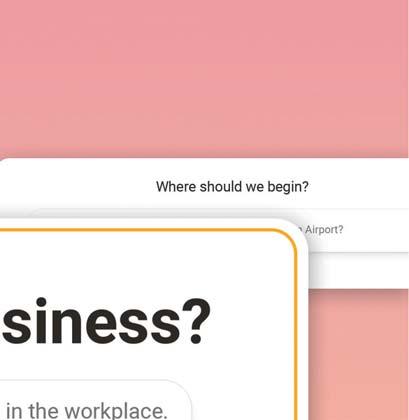




















Powered by
Powered by

In partnership with Medical Mutual, we are offering an expanded ChamberHealth® program to provide you – our members – with premium health insurance coverage while saving you money through group buying power. Through this partnership, we are now able to offer ChamberHealth insurance plans to businesses from 1 to 500 employees in the state of Ohio – an expansion of the program that was previously only available to companies from 2 to 99 employees.
*ADDITIONAL PLAN OPTIONS INCLUDE:
• Prescription drug coverage
• Wellness programs
• Identity theft resolution and remediation services are offered at no additional cost.

Through ChamberHealth, small businesses and sole proprietors – a first for the ChamberHealth program – can partake in a self-funded insurance plan. Being self-funded has many benefits, including:
• The ability to keep costs low since MEWAs are not subject to some of the Affordable Care Act’s (ACA) mandated benefits and taxes
• The cost of benefits reflects the unique health of the company and its employees, recognizing that a healthier team should create a better benefits cost outcome
• All benefit options are tied to Medical Mutual’s large network of doctors and hospitals, including TriHealth, the Christ Hospital Health Network, and Mercy Health TRADITIONAL COPAY AND HIGH-DEDUCTIBLE PLANS WITH HSA



YOUR WAY TO GO...













Say goodbye to traffic, parking, and stress & discover freedom of movement with Metro!
Metro isn’t just a ride; it’s your ticket to exploring all the best Cincinnati and Hamilton County have to offer. Whether you’re cheering for your hometown team, savoring a 5-Way at your favorite chili spot, or heading Up the Hill for a new adventure, Metro makes it easy, affordable, and comfortable.
Metro offers 24/7 service on 7 key routes, more weekend options, increased frequency, better connections, on-demand transit with MetroNow!, new buses loaded with free Wi-Fi and charging ports, and upgraded bus stops and a new transit shelter.










ROW YOUR BOAT
Ohio River Paddlefest brings 2,000 people to the river
12 ARTS & CULTURE FOCUSING ON THE FUTURE
Film Cincinnati’s Kristen Schlotman is channeling the city’s Sundance flirtation into more movie production
14 ECONOMIC DEVELOPMENT
A MARKET FOR MORE BUSINESS
A new report highlights Findlay

Market’s $1.1 billion impact on the region’s economy
16 PHILANTHROPY
TRANSFORM THE REGION
The Greater Cincinnati Foundation launches a new $1 billion strategy over the coming decade
18 ARTS & CULTURE SOAK IN THE RIVER CULTURE
America’s River Roots will kick off the nation’s 250th birthday celebration in October

08 BY THE NUMBERS
The Cincinnati region could create more than 16,000 new jobs and $4.8 billion in economic impact by investing in “green” industries, according to a new analysis.
and


22
LOCAL EXPERTS SAY AI IS GOOD FOR BUSINESS
Meet five digital leaders who have embraced artificial intelligence tools in the workplace.
30
WILL LUNKEN AIRPORT’S REBIRTH FINALLY TAKE OFF?
A public-private project could add a hotel and event center at the iconic airfield.
36 STEPPING UP FOR SECOND-CHANCE HIRING
Hiring formerly incarcerated employees is good for the community and often good for business, too.
42
HOW, WHEN, AND WHY TO SELL YOUR BUSINESS
Here are insights into making a successful exit through preparation, market awareness, and connections.
Last week our family got a new dog. He needed a name, and I hate to admit it but I turned to ChatGPT for ideas. After a few queries and some refinement, we found his new name in one of the lists it provided.
It was an interesting back and forth, and as a later adopter to the tool I found ChatGPT to be a little addicting. I asked myself lots of questions: How can I save time, how can I learn more quickly, and how can I use the tool to improve our work? And then I asked it a lot of questions
In that spirit, this issue of Realm has a fantastic look at how five local leaders are using AI to grow their businesses and improve their processes. It’s an accessible article full of helpful tips, so if you’re a veteran of AI, a newbie, or even a resistor (it is a little frightening), you’ll find a lot of insight in this story.

You’ll also find an article that envisions the rebirth of Lunken Airport, thanks to a bold new development by the team that brought us Hotel Covington, and a story about how and when to consider selling a business—and buying one, too!
And, as always, you’ll read about some of the interesting people and bold initiatives helping our region grow. We hope you continue to enjoy Realm and the content that the team at the Chamber and Cincinnati Magazine produce in these pages. Please send your feedback along with ideas of what you’d like to learn about next. Email me any time.
P.S. We named the dog Jed. He’s a good boy.
BRENDON CULL BCull@cincinnatichamber.com








































































In Cincy, meetings aren’t just events, they’re experiences waiting to be crafted. Discover Cincy’s endless meeting optionsthey’re Fresh, Bold, and New!

PUTTING A BIG NUMBER ON FINDLAY MARKET’S ECONOMIC IMPACT
Get a jump on news about a push to create more “green” jobs and the Greater Cincinnati Foundation’s intention to invest $1 billion over the coming decade. And catch up with Film Cincinnati’s Kristen Scholtman, who is bringing more movie production (and George Clooney) to town, as well as plans for America’s River Roots.
A new report estimates that private and public investments in “green” industries across our 15-county region could generate between 16,372 and 44,145 jobs and have an overall economic impact ranging from $4.8 billion to $11 billion. Cincinnati Green Workforce Landscape Analysis, produced by the Cincinnati Regional Chamber with support from the city of Cincinnati and Co-op Cincy, defines green jobs as those producing goods or services that benefit the economy, conserve natural resources, or make production processes more environmentally friendly or less resource intensive.
AND INDIRECT GREEN JOBS CAPITAL INVESTMENTS WILL DRIVE THE GREEN ECONOMY JOB CREATION




Ohio River Paddlefest returns on August 1-2 with an outdoors expo, leisure and race paddle events on the river, and a Finish Line Festival. All proceeds support Adventure Crew, the nonprofit organization that connects teens in the region with nature activities.
All Paddlefest participants put-in on the Ohio River the morning of Saturday, August 2 at Schmidt Recreation Complex in Columbia-Tusculum. The 4.5-mile paddle ends at the Public Landing downtown, while the 9-mile paddle continues to Gilday Riverside Park beyond Sedamsville.
All boats and floats are welcome at Paddlefest. Besides the leisurely paddle options, the Seven Bridges Race features youth, men’s, and women’s categories in various craft divisions, from canoes and kayaks to paddleboards.
Outdoors for All Expo kicks off at 4 p.m. Friday, August 1 at Schmidt Recreation Complex. Paddlers and non-paddlers alike can browse exhibits from local parks, outdoor outfitters, adventure experts, and environmental organizations, plus enjoy beer, food trucks, and live music.
Ohio River Paddlefest was launched in 2001 and has become the nation’s largest paddling celebration, attracting more than 2,000 participants each year now. Registration for leisure paddlers runs from $20 for youth to $75 for adults onsite at the event. Boat rentals are available for a separate fee.


IIt was only a “miss” if you’re a glass-half-empty kind of person. But for Kristen Schlotman, executive director at local nonprofit Film Cincinnati, landing on the list of three finalist cities to host the Sundance Film Festival going forward was just the beginning—a win that put the region’s film scene on the map in a highly competitive, global industry.
“Contrary to the notion of ‘losing’ Sundance, Cincinnati never lost anything,” she says of the announcement that the festival would relocate to Boulder, Colorado. “You had to have it to lose it. Rather we gained an abundance of recognition and awareness and became an integral part of a crucial, ongoing conversation. Film Cincinnati is more energized than ever to elevate the region’s vibrant film ecosystem and seek innovative ways to diversify and expand its impact on the creative economy.”
Film Cincinnati started in 1987, and Schlotman has been on a mission to not just put Cincinnati on the map in the film industry but to create an environment here that makes the region a premier destination. “It’s been immensely rewarding to be a catalyst for positive disruption and to champion the growth of our creative community,” she says.
All eyes are now on Film Cincinnati’s next steps. “It’s shaping up to be an incredible year, with a growing number of productions already lined up,” says Schlotman. “We’re seeing a notable uptick in projects getting greenlit, and we’ve never been busier. The appetite to create something larger and more impactful—for both the community and the industry—is palpable.”
Schlotman recently returned from the Cannes Film Festival, where The Mastermind, filmed entirely in Cincinnati last year, had its world premiere. Her organization will host Cineposium Cincinnati in September, produced by the Association of Film Commissioners International to tackle topics such as creating a fi-

nancially sustainable film festival and the future of independent filmmaking. George Clooney will be the event’s headline speaker.
“What’s especially exciting about the conference is it’s the first time in North America in eight years and, for the first time, it will be open to non-members,” says Schlotman. “We fought incredibly hard to make this open admission a reality because we wanted to ensure access for both our established film community and those interested in exploring these conversations and opportunities. It’s part of our mission to broaden impact and continue to attract and retain talent in our thriving creative community.”
Schlotman hopes to see local filmmakers and workers at the conference, which she says will be “four thrilling days” in which studio executives, film distributors, agents, and others gather and collaborate in Cincinnati for panels, workshops, keynotes, and an “incredible sense of community and fun.” Register at afci.org/ cineposium-2025.
Being a Sundance finalist city “gained Cincinnati an abundance of recognition and awareness and became an integral part of a crucial, ongoing conversation.”


Cincinnati Works partners with top regional employers to help frontline talent—while reducing turnover and boosting performance. From career readiness to lifelong coaching and barrier removal, we help you invest in your people—so your business grows stronger.




A new report highlights Findlay Market’s $1.1 billion impact on the region’s economy.
–ALEXANDRA FROST

Few Cincinnati places go back as far as Findlay Market. In the 1850s, you didn’t just go for the food, but for political meetings, voting, and rallies for the volunteer militia, among multiple reasons.
Founder James Findlay likely wouldn’t recognize the bustling multi-location market it’s become. As many as 522 total businesses are located in Findlay Market, have started in or participated in a Findlay program, or scaled out of Findlay Market into stand-alone locations, according to a new report, Economic Impact of Findlay Market
The operation had $1.1 billion in economic impact in the five-year period of 2018-2023, supporting 4,175 jobs and $241 million in earnings.
While many of us know that Jane’s is the best place to grab a drink after work or where to buy real bacon for a family brunch, we might not fully realize the extent of the market’s impact on the local economy and business scene, says Kelly Lanser, president and CEO of the Corporation of Findlay Market. The city’s last remaining public market is one of Cincinnati’s top five attractions, receiving 1.2 million visitors annually.
“Findlay Market is so much more than just a collection of shops. It’s an economic and cultural center that helps drive the vibrancy of our urban core,” Mayor Aftab Pureval shared in the report, which was prepared by the Cincinnati Regional Chamber’s Center for Research and Data. “Findlay Market is inextricably tied to our history, our future, and our identity as a city.”
Lanser calls Findlay Kitchen, Findlay Launch, and Findlay Learn the market’s core programs. Kitchen is a food business incubator program, Launch provides a brick-and-mortar storefront to new business concepts for 15-month periods, and Learn teaches how to run a small food business, including legal, HR, and brand identity aspects. The report found that 95 percent of Kitchen participants and 100 percent of Launch concepts are minority-, women-, or immigrant-owned businesses. “All of these things are helping teach people the business side of running a food business,” Lanser says. “Running a small business is the hardest thing anyone can do.”
Her goal is to have two-thirds of the market remain fresh foods, a difference from some other public market models with an increased focus on prepared foods. “That’s fine for them, but that’s not what Findlay Market is,” she says. “It’s fresh food for everyone, which is why we have multiple butchers, cheese mongers, etc. We want price points for everyone who shops here.”
The report projects $483 million in economic impact from 2024 to 2026. The market is launching a $21 million capital campaign to update historic infrastructure, expand its produce prescription box program, build an online curriculum, create an operations center, and more. “People recognize the market as a cultural hub, but my hope is people will recognize Findlay Market as the economic engine that it is,” says Lanser.



The Greater Cincinnati Foundation launches a $1 billion strategy to improve education and housing and support cultural vibrancy. —SARAH M. MULLINS
Th e Greater Cincinnati Foundation (GCF) recently announced a $1 billion strategy aimed at fundamentally transforming the region over the next 10 years. Through hundreds of conversations with community stakeholders, President and CEO Matthew Randazzo says three critical areas surfaced as essential to the region’s future: educational outcomes, affordable housing, and enhancing community and cultural vibrancy. They’ll work in concert with each other to make Cincinnati more competitive in attracting residents and businesses and increasing economic investment.
“We want to build a region where—regardless of where you live in the city—you have access to a really high quality school option,” says Randazzo. “And regardless of where you choose to grow your family, you have access to quality, income-aligned housing that’s situated in a neighborhood you’re proud to call home.”
According to a Realtor.com report in October 2024, the Cincinnati region experienced a 4.2 percent increase in rents year-over-year,
more than any other major U.S. metro area. And Zillow reported Cincinnati as the second hottest market in 2024 with average home value at $240,393, up 8.1 percent. Those numbers show that Cincinnati is in demand, but they also mean decreased access to affordable housing.
“We’re pricing our friends and neighbors out of the neighborhoods they want to live in and delaying or deferring the American dream of being able to purchase a home and build wealth through home ownership,” says Randazzo. “The foundation is going to focus heavily on how many new affordable housing units we are able to produce, how many are we able to preserve, and how we keep families, particularly families with school-age children, stably housed.”
Randazzo notes that housing and education work together, citing that when students change schools even once during the academic year it causes months of learning loss, especially for low-income students. Maintaining stable housing helps reduce disruption, he says.
GCF’s work will also focus on literacy and

increasing pathways to good jobs. Randazzo says third grade literacy is among the single best predictors for whether students will successfully progress through middle school and be proficient by eighth grade—another milestone that predicts whether a student will graduate from high school and be able to access college or a living wage career. Thus childhood literacy impacts the pathways toward good jobs, he says. “We want to help create meaningful pathways for students to pursue the career of their choosing, find training or certificate programs, or have the ability to serve in the military. These are all real challenges within the region at this point.”
Cincinnati’s community and cultural vibrancy is a competitive advantage relative to other big cities in Ohio as well as the Midwest. “We know this is a town that punches above its weight culturally,” says Randazzo. “With better quality public schools and affordable income-aligned housing, that vibrancy will continue.”

PresentedbySaraLee,theannualBust-a-Crust Thanksgivingpiefundraisersupportsourmissiontodeliver essentialservicesthatpromotetheindependenceof seniors.ALLproceedsfrompiesalesandsponsorships directlybenefitservicesfor10,000seniorsinourregion.
PresentedbySaraLee,theannualBust-a-Crust Thanksgivingpiefundraisersupportsourmissiontodeliver essentialservicesthatpromotetheindependenceof seniors.ALLproceedsfrompiesalesandsponsorships directlybenefitservicesfor10,000seniorsinourregion.
Sponsorsenjoy:
Sponsorsenjoy:



SERVEUPSOMETHINGDELICIOUS
America’s
River Roots helps kick off the country’s 250th birthday celebration in October.
—BILL THOMPSON
As the U.S. heads toward its 250th anniversary in July 2026, a festival on the Ohio River this fall will serve as one of the first big celebrations. America’s River Roots is a five-day shindig October 8-12 billed as an exploration of the culture, cuisine, and music that made the area’s river cities what they are today.
“We want to celebrate the people, whether they came here 250 years ago or 186 years ago at the time of emancipation or five years ago,” says Susan Fisher, executive director of the event that features Governors Mike DeWine of Ohio and Andy Beshear of Kentucky, Cincinnati Mayor Aftab Pureval, and former Ohio Senator Rob Portman as honorary advisory board co-chairs.
On paper, the festival resembles Tall Stacks, which had six iterations from 1988 through 2006. Fisher salutes that event but says there is a crucial difference. “This is not a riverboat festival with music, but a music, culture, and food and drink festival with riverboats. The world has changed since (Tall Stacks), and we have the opportunity to make the event more inclusive and broader in scope.”
In addition to eight free stages of music on both sides of the river (plus one ticketed venue for each day’s headliner, including Weezer) and more than 185 riverboat cruises (starting at $20), River Roots will feature food from dozens of specialty vendors as well as classic

Cincinnati providers such as Skyline Chili and Graeter’s. It will also shine a light on Kentucky’s distilling history and Cincinnati’s brewing past and renaissance.
Education programs will spotlight the Freedom Journey, the National Underground Railroad Freedom Center, and Black Music Walk of Fame. There will also be River Talks and Riverwalks on both sides of the river with an app explaining what happened where along the route. “(Local singer and arts activist) Kathy Wade is creating an interactive program called
Sounds of the River to explain the river’s musicology from the diverse populations that traveled it,” Fisher says. “It will highlight the early drumbeats of Africa through the banjo and harmonica that led to blues, country, zydeco, and any number of sounds.”
Although the festivities officially begin on a Wednesday, two special events will prime the pump. On Saturday, October 4, volunteers for the Ohio River Valley Sanitation Commission (ORSANCO) will clean the river banks on both the Ohio and Kentucky sides for five miles. Then on Tuesday John Morris Russell and the Cincinnati Pops will premiere an original piece of music at Music Hall to pay tribute to the festival’s arts supporters.

An impact study done by Northern Kentucky University projects River Roots will pump $150 million into the region’s economy. If that happens, can organizers wait another 250 years to host it again? “We do want to create a demand for this type of event to continue,” says Fisher. “I think there’s space for it. But let us do it once and then see where we stand.”



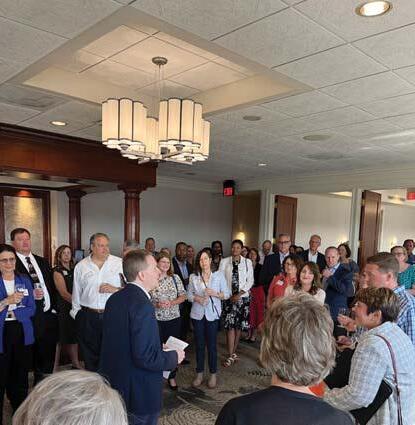













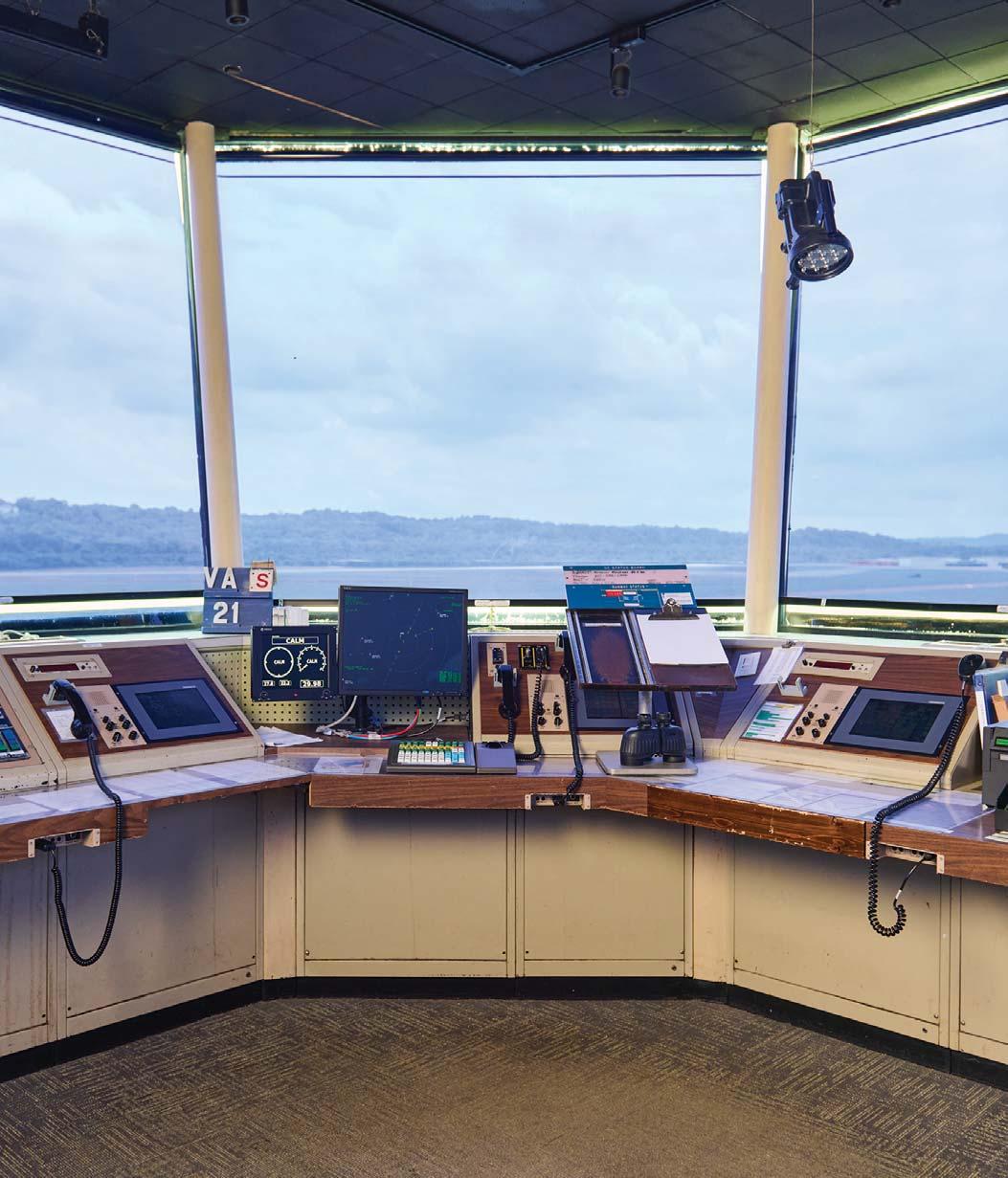
We’re living in a world today where anyone can ask ChatGPT anything. Virtual assistants answer emails and sit in meetings as a proxy for their humans. Robots complete manual tasks that only humans could do before. Organizations develop machine-learning algorithms to predict future trends, such as pricing.
Artificial intelligence is here, and it’s expanding throughout our consciousness and our lives with great speed. Realm sits down with five leading AI experts in the region to collect their insights on and advice about this new horizon of technology and how it will impact the workplace and business in general.
Kendra Ramirez has a favorite T-shirt that reads: HI>AI. “Human intelligence is greater than artificial intelligence,” she says, adding that it’s been a guiding principle at her consulting agency as well as at Cincinnati AI for Humans, a networking group she co-founded with Helen Todd in 2023 that’s grown to more than 1,400 members.
Ramirez is known for making AI approachable. “I apply everything to how an organization or business is operating and working today,” she says. “I see it very much from the human element.”
For the last 20 years, her agency has worked to keep clients ahead of the digital curve, mainly on websites in the early years. Ramirez has offered AI
ALL
TO DO THE SAME.
BY CARRIE BLACKMORE ILLUSTRATION BY JANNE IIVONEN


“I FEEL PASSIONATELY THAT AI DEMOCRATIZES SOCIETY, BECAUSE ANYONE CAN USE IT. I DON’T WANT ANYONE LEFT BEHIND,” SAYS KENDRA RAMIREZ.
services since 2018, likening the advent of artificial intelligence to the introduction of the car during the heyday of horses and buggies. Both advancements can amplify what hu-
man beings capable of, if they learn how to drive.
“In every technology shift, it’s women, minorities, small businesses, and nonprofits that get left behind,” Ramirez says. “I feel passionately that AI democratizes society, because anyone can use it. I don’t want anyone left behind.”
Her agency provides a suite of AI services from education, readiness, and strategy to implementation, policy creation, and training. She also advises clients on how to create an AI Task Force or AI Council to keep up with AI’s constant advancements. “We’re often
brought in with the question Where do we start? or What else should we be considering?” says Ramirez, who has tested more than 100 AI tools at this point.
She’s seen some impressive results. One team saved 1,400-man-hours by applying two AI tools. The first was a transcription tool to automate and summarize meeting notes, recaps, and next steps, while the second streamlined the company’s documentation review process. She found a tool for another one of her clients that cut down podcast editing from an average of seven hours to 40 minutes.
“Do we feel lazy or guilty using a formula in an Excel spreadsheet? No, we don’t,” Ramirez says. “Right now, AI is a competitive edge, but it’s not always going to be that way. The generation being born right now isn’t going to talk about AI—they’re just going to talk about work.”
Ramirez encourages those with a piqued interest to attend a monthly Cincy AI for Humans meeting at the University of Cincinnati’s Digital Futures building. Find their meeting schedule at cincyai.org.
If you’re a business or nonprofit leader and want to start exploring the use of artificial intelligence in your company or nonprofit, Sandy Steiger’s advice is to first identify the problem you want to solve. Is there a tedious task your staff is always complaining about? Where is time being wasted or opportunity lost?
“If your mission is to use artificial intelligence so that you can say your company is doing artificial intelli-
gence, then you’re coming at this all wrong,” says Steiger of Lithko Contracting. “The companies that will be most successful are the ones with a vision and a strategy and know what problems they need solved. Then you can ask, How does AI plug in?”
A self-described numbers girl at heart, Steiger earned a master’s degree in statistics and worked as a data analyst at dunnhumby and a data scientist at 84.51 before teaching business analytics at Miami University for six years. She left academics three years ago to take a senior position at Total Quality Logistics, and she joined Lithko in May.
TQL was an early adopter of AI, and today it uses AI tools to forecast markets, predict pricing, consolidate loads, and find the best freight carrier. The brokerage firm has 40 bots in operation to automate manual and repetitive tasks that before took the time of 90 people, Steiger says.
Before any organization, big or small, launches its own AI journey, leaders must understand their own data and make sure it’s accurate and complete before going any further, Steiger says. Once you’ve determined you’re at a good staring place, she suggests thinking big and starting small, sharing an example from the U.S. Postal Service.
“Their customer service agents are inundated and are getting too many calls,” Steiger says. “But they started small. They said, What’s the number one thing to solve for? What do we get a question about most often? It turns out to be, Where’s my package?” So USPS created an AI tool to automate package tracking on its website and on the phone, freeing up customer service people to answer other questions.
Steiger suggests using ChatGPT
to brainstorm ideas, too, but offers a warning. It does require a new way of thinking, perhaps even a different level of critical thinking. “AI is going to answer almost every single question you ask it, but it might not be the right answer,” Steiger says. “You have to ask yourself, How do I research that to make sure it’s real?”
Part of Steiger’s role at TQL was
to serve as a bridge between the technical folks and everyone else in the business, and she says it’s important to have everyone in the room as you work on finding solutions in order to get buy-in. She also cautions business leaders to monitor their AI tools because—while they’re getting better at what they do all the time—they can produce factually inaccurate or

illogical answers due to data and architectural constraints.
“If you’re thinking about machine-learning algorithms in the predictive and prescriptive space, you’ve got to be looking for drift,” Steiger says. “Maybe that’s because new data has been coming in or there’s been a shift in the market that makes the model perform less ideally than we would like.”
Two things are inevitably true, Maddie Bell says: Humans will always have meetings, and the way humans orchestrate those meetings will continue to change based on the technology and tools available. She’d like to introduce you—partic-

ularly if you lead a business that sells something—to Synapsa, an AI solution for meetings that she and her co-founder and husband Mike Bell have developed for the sales industry.
“Businesses need to engage buyers the instant they raise their hand,” Bell says. “It isn’t enough to do it in days. It’s not even enough to do it in under five minutes. You need to engage them the instant they say, Hey, I think I’m interested. You immediately need to understand whether they’re a good fit for your business.”
It turns out that AI can be good at this task, Bell says. While scheduling a meeting might seem like a moment in time, there’s actually a whole set of conversations that must happen as well as context added, Bell says, before you can get to a potential sale. Not to mention that 40 percent of meetings are rescheduled, changed, or double-booked, she says. If the buyer doesn’t end up qualifying? More waste of time.
Synapsa develops artificially intelligent systems that have those conversations with potential buyers and then convert the conversations into meetings, ultimately creating a path to new business growth. “AI that serves people and actually creates more of the right human-to-human connections,” says Bell, “because now you’ve matched the buyer’s intent with the right next step.”
Bell left her position as a brand director at Procter & Gamble two years ago to join her husband, who left his position as vice president of data engineering and machine learning at Nielsen, to create Synapsa. Their AI tools engage with potential buyers via a company’s website, by email, or by text.
For example, Synapsa developed a webchat for one client to engage
with 500 of the 200,000 visitors who came to their site. Thirty-three ended up being qualified buyers, but the connections achieved with AI brought in multiple six-figure deals. “You’re never going to pay a human to do that,” Bell says. “But of those 33 qualified leads, 25 meetings got booked. That’s a 78 percent book rate, which is massive.”
Synapsa built a tool for another client that sent out 200 texts, booked 41 qualified leads, and cleared multiple deals. “We always tell people micro moments do have a macro impact at scale,” says Bell. “These conversations on the website, these content downloads, these making sure people are going to show up to the call, the result is that macro output.”
Synapsa is continuing to transform as AI develops and its uses expand, Bell says. “What you were building yesterday isn’t what you’re building tomorrow, because the landscape is moving so quickly.”
CEO OF BRANDRANK.AI
When ChatGPT was publicly released on November 30, 2022, Pete Blackshaw was on vacation with his family. As they slept, the former digital marketing executive for Procter & Gamble and Nestlé found himself obsessively plugging in questions: Is such-in-such brand sustainable? What do consumers feel about this product or another?
“I was kind of blown away at how uncomfortably honest AI is about brands,” Blackshaw says. “ChatGPT is like the gift of simplicity, and now you can do it with voice. I was thinking, Someone’s got to create a meter
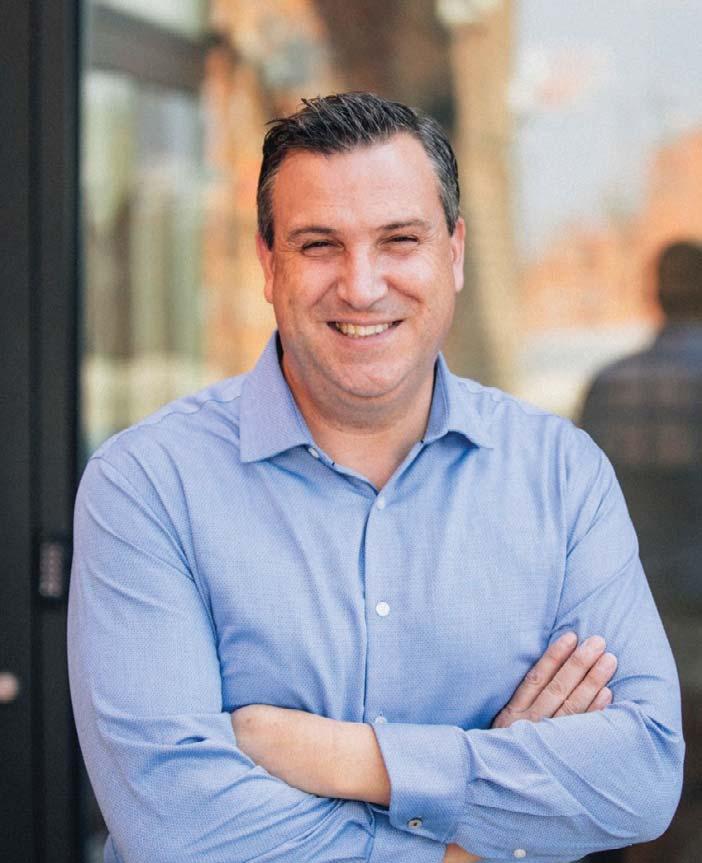
to help brands understand what’s being said about them.”
And so he did, leaving his job as chief operation officer at Cintrifuse, the “fund of funds” startup incubator that transformed into a local venture capital group a couple of years ago, to build Brandrank. ai with co-founder Hank Hudepohl, a former executive at TripAdvisor and Paycor.
ChatGPT is just one of a growing number of AI-driven search and discovery tools, Blackshaw says. There’s
also Gemini, Perplexity, DeepSeek, Grok, and Anthropic. Brandrank.ai conducts an audit of them all, based on three metrics: visibility (does the brand show up in AI-driven searches), vulnerability (what are they saying), and readiness (how to operate in order to protect your brand). “You really need to understand how the algorithms harvest data,” he says. “Your brand is a smoothie in the world of Generative AI, but you need to make your ingredients accessible. Brands need to think differently about how
Business leaders are asking Kendra Ramirez, a consultant who’s tested more than 100 AI tools, basic questions about artificial intelligence, such as “Where do we start?” and “What else should we be considering?” She says AI can be a competitive edge “right now” but will be commonplace soon.
Pete Blackshaw calls AI “the world’s greatest gift to entrepreneurs,” because it makes work more efficient and less expensive. He launched his new start-up, Brandrank. ai, with $1.2 million in seed funding—just a fraction of the $31 million it took him to launch an earlier start-up.
Jorge Perez uses AI to expand YMCA support services with a limited staff. “I believe we have an opportunity to scale what for many of us has been impossible,” he says.
they get their story out there.”
He sees Brandrank.ai as a platform for brand health and trust in the fast-growing “Answer Engine” measurement space, and it’s getting noticed. In March, Brandrank.ai beat 500 other start-ups to win HumanX, a competition for AI-first companies backed by Google Cloud, and Blackshaw made the inaugural “AI Trailblazers Power 100” list in April chosen by Adweek magazine and the invite-only industry group AI Trailblazers.
Being AI-first means Brandrank. ai is using AI for just about everything, Blackshaw says, including 90 percent of its coding. His team even made him a bot that’s continuously learning how he speaks and thinks. “A bot that can write articles like Pete,” he says. “Even in our delivery with clients, there’s artificially generated Pete sitting on his little pedestal giving advice, sometimes in Spanish, sometimes in English.”
Blackshaw says there are a lot of complicated questions still to be managed around disclosure, meaning that people need to know if and when they’re talking to human Pete and when they’re talking to the bot. “But I do think it opens up a lot of possibilities. I mean, people like the energy of people, and some of that can be automated.”
Blackshaw calls AI “the world’s greatest gift to entrepreneurs,” because it makes work more efficient and less expensive. He launched Brandrank.ai with $1.2 million in seed funding—just a fraction of the $31 million it took him to launch an earlier start-up, Planet Feedback, which was eventually sold to Nielsen.
“AI is the great equalizer,” he says. “The public tool has been available for less than three years. Things are
happening at warp speed. Companies, particularly big ones, need to have their eyes really, really wide open and be a little bit paranoid.”
JORGE PEREZ, PRESIDENT AND CEO OF YMCA OF GREATER CINCINNATI
Every Monday, an AI agent that Jorge Perez built sends him an email. “The agent has been trained to look at my personality profile and the YMCA’s strategic plan and share with me a principle to help me be a better CEO,” he says. If you think that’s impressive, hold onto your hat.
At 60, Perez often finds himself the oldest person in a room of AI adopters, but since he was a kid who saved his money to buy the first Commodore 64 he’s been enthusiastic about technology’s advancement. He says he began to recognize AI’s “extraordinary capacity to help individuals do their work” when he began using ChatGPT. As the head of the YMCA of Greater Cincinnati, he oversees 13 membership locations serving about 140,000 individuals a year, as well as 70-plus before- and after-school child care sites and four early learning centers in a five-county region.
“We’re not using AI to find a way to replace people but really to empower them and supercharge their ability to do our mission to help people achieve, relate, and belong,” says Perez. “Now we’ve got this new set of tools, this new team that has come alongside us, helping us do it faster and better.”
The “team” of which Perez speaks is made up of 16 AI agents developed inside ChatGPT. There’s Yasmine, an AI agent for youth development.

Finley takes questions about fundraising, and Izzy is the IT advisor. Marlow can help with membership questions, and Harmony is an expert at human resources. “This stuff is so amazingly user-friendly,” Perez says. “We designed one in about 45 minutes and then we said, Let’s design 15 more. It’s just like creating a job description—you want them to have five years of experience, be able to do X, and have a degree in marketing, for example, with Morgan.”
In developing the agents, the
YMCA added organizational background, values, protocols, and all of the material it would need. It’s like hiring a college graduate who’s been through orientation and remembers everything, Perez says.
Created and monitored in Cincinnati, the agents have been rolled out to the entire YMCA system throughout the U.S. and Canada. Each answers questions 24/7 and can take 150,000 questions at a time, Perez says. And the more that staff members use them, the more the
agents learn and improve. “When you’re in the business of trying to serve everyone and you have a limited staff to do it, the idea of all of a sudden having more support is just exciting,” says Perez. “That means we can do far more than we can do right now.”
The agents have their limitations, he says, and he teaches his staff to be on the lookout for the moment when a consumer situation needs human-to-human engagement.
The Y is headed into Phase 2 of its AI integration, Perez says, looking at creating agents for every employee and how AI tools could work with its other systems. They’re discussing connecting the cameras at the physical Y locations to an AI agent, which is asked to watch for and alert them if a senior falls, a child is crying, a fight breaks out, a car gets broken into, or an adult who visits frequently is having difficulty making friends.
“It could become an extension to the strategy that you’re trying to reach,” he says. “I believe we have an opportunity to scale what for many of us has been impossible. It can be used for good, and that’s what I’m interested in.”
BY JOHN STOWELL
Guy van Rooyen wants to make Lunken Airport cool again. He envisions the airfield, now 105 years old, teeming with excited children looking skyward at an approaching jet. He sees a smartly-dressed doorman ushering a rock star into the lobby of his luxurious boutique hotel. The lunch crowd in the terminal’s new restaurant is a mix of airplane mechanics, hikers and bikers just off the trail, and neighbors from Linwood, Hyde Park, and Anderson Township.
Under the watchful gaze of two iconic murals that have graced the art deco termi-
nal for nearly 90 years, a vibrant new life is coming to the eastside home of one of America’s first and, at the time it was built, largest municipal airports. “The building is a jewel,” says van Rooyen of the terminal building, “and we plan to bring it back to its former glory.”
South African by birth, van Rooyen, 48, emigrated from Australia to Cincinnati in 2004. As CEO and president of vR Hospitality, he’s focused on redeveloping historical structures—the most recent being the expansion and renovation of Hotel Covington.
When the city closed Lunken’s ter-
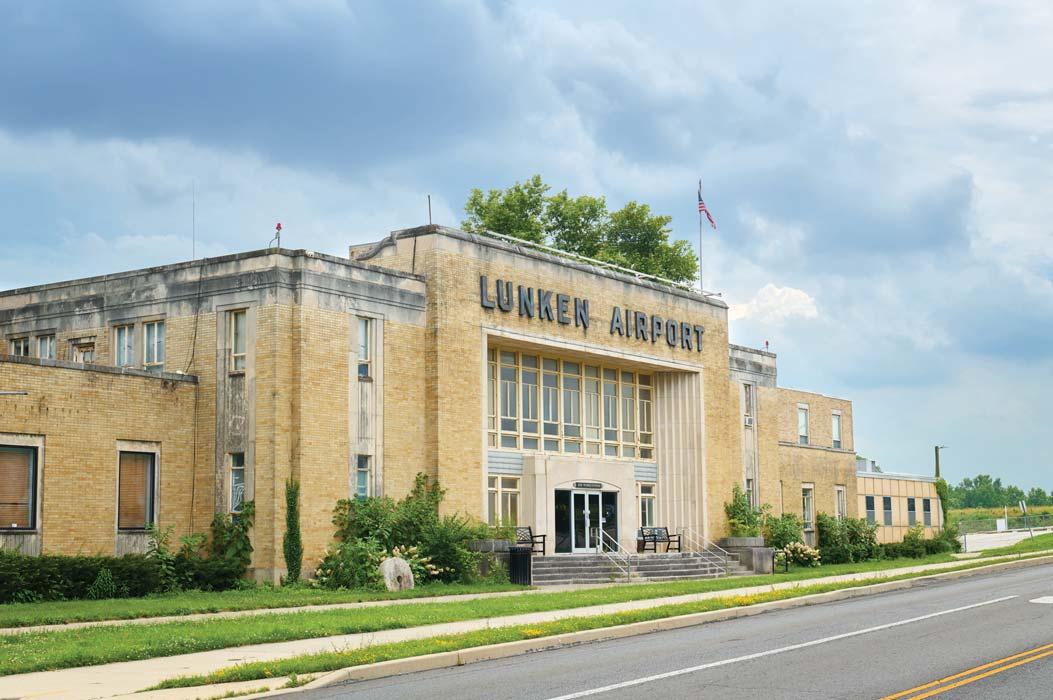
minal building in 2022 for “renovations,” there was a fair amount of skepticism that it would ever again open. We were just beginning to emerge out of the pandemic, and there was empirical evidence already that businesses on the margin before COVID weren’t coming back. At Lunken, the pandemic bludgeoned air traffic and the Sky Galley restaurant had shuttered. The airfield’s only commercial carrier, Ultimate Air, wasn’t returning.
Enter van Rooyen, who frequently drove by the Wilmer Avenue building as he took his kids to soccer practice. It was a red-letter trip to the pitch, he recalls, if a plane was landing or taking off. “There’s something about being that close to planes that kids really love,” he says.
When the city issued a request for proposals to replace Sky Galley, van Rooyen jumped on it. With both feet. “I don’t think any of us were prepared for what Guy proposed and what it would require,” says Markiea Carter, the city’s director of community and economic development. “But were really excited about it.”
Carter believes the project can be a game-changer for the east side, and so the city was on board from the beginning. City Council voted unanimously in December 2021 to approve van Rooyen’s conceptual design and grant the project a 30-year tax abatement. In addition to a new 100-seat restaurant and bar, the proposal includes a three-story 50-room boutique hotel, an event center, a rooftop bar, and an aviation museum. The addition would be built behind the existing art deco terminal building, and van Rooyen was planning to open everything in 2023.
Then he suffered through what he calls “one of the worst days of my life.” He and his architect, Ron Novak of Oakley’s Drawing Dept, had been

given an incorrect set of numbers relating to height restrictions that surround the working airport. “We were too high by about six feet,” van Rooyen says, clearly still feeling the sting of a year’s worth of work that evaporated in a meeting with the Federal Aviation Administration.
He doesn’t blame the FAA. Their job is safety, he says, and you can’t have a structure hanging over what the FAA terms its “area of operations.”
The vR team went back to the drawing board.
LUNKEN OFFERS UNIque challenges to developers that they rarely see elsewhere. It’s a working airport, and it’s also in a flood plain. “What you get is the FAA telling us we have to build down and FEMA (the Federal Emergency Management Agency) telling us we have to build up,” says van Rooyen. He uses the word “tricky” several times but seems like a man who understands the hoops and how to jump through them.
Jaime Edrosa is well aware of the topographical idiosyncrasies of his
beloved airport. He’s been the airport manager since fall 2023, achieving what he says has always been his dream job. His aviation career started in Reno, Nevada, but he moved to Cincinnati to take jobs first at Amazon Air and then at CVG, where he served for four years as the airport’s telecommunications manager.
He sits in a cramped office at a metal desk, surrounded by maps and aerial photos of Lunken—one taken before the Little Miami River was rerouted by the Army Corps of Engineers to help create the airfield. Three floors above him, two air traffic controllers keep watch on the skies.
“That’s our midfield now,” he says of the river photograph. “Some call it Lake Lunken. It’s a big hole in the center and it fills up when it rains.”
The more common moniker, “Sunken Lunken,” makes it difficult to utilize much of the space on the 1,140-acre grounds. A black brick on the old terminal—the one van Rooyen plans to bring back to life—marks the spot where the 1937 floodwaters peaked. It’s as high as the base of the control tower.

Guy van Rooyen, who renovated and expanded Hotel Covington (above), wants to bring back Lunken Airport to its “former glory.”
“THIS IS A SUBSTANTIAL ECONOMIC DEVELOPMENT PROJECT THAT DOESN’T DISPLACE ANYTHING OR ANYONE,” SAYS MARKIEA CARTER, CINCINNATI’S DIRECTOR OF COMMUNITY AND ECONOMIC DEVELOPMENT.
The temperamental Little Miami River, persistent ground fog, and expansion constraints were the reasons why, in 1947, regional leaders decided to build a new airport in Boone County. The move south of the Ohio River still perplexes many a tourist who can’t figure out why Cincinnati’s airport is in Kentucky.
It’s a mistake, though, to say Lunken was “replaced” by CVG. Repurposed, yes, but Lunken remains an active airfield. In fact, it’s the most ac-
tive airport in Ohio, with around 125,000 takeoffs and landings a year—more than John Glenn International Airport in Columbus or Hopkins International Airport in Cleveland. Even during COVID, when business travel shriveled, Lunken was guiding 84,000 planes in and out of its airspace. Traffic has been steadily growing back since 2020.
Lunken’s business hinges on a variety of customers. Five flight schools operate on the grounds, joining dozens of charters like Executive Jet Management or Waypoint Aviation in the hangars and on the runways. Corporate jets owned by Procter & Gamble, Macy’s, Kroger, or American Financial Group are always on call. Military aircraft make occasional

stops, and there’s always a stream of private aircraft touching down.
Lunken is its own economic zone with several aircraft support companies—all of them leasing space and hiring skilled workers—occupying hangars, offices, and maintenance structures. It’s also self-sustaining, says Edrosa, with Lunken collecting landing fees, land and facility rent, fuel surcharges ranging from 6 to 12 cents a gallon, and 1 percent of gross revenue from each of its tenants.
He discovered in 2023 that many of Lunken’s fees hadn’t been updated for years and were significantly below market rate, so he’s already adjusted the landing fees, started developing the facility’s first-ever strategic business plan, secured several federal grants, and welcomed the U.S. Customs and Border Patrol to his campus, which in turn has increased international cargo traffic. “This is a working airport,” Edrosa says with pride, “and we are in a good position because of where we’re located to take care of

growing demand.”
When van Rooyen reopens the old terminal, his businesses will provide yet another revenue stream— though the airport’s future remains up in the air. Last year, the Cincinnati Futures Commission suggested city leaders should consider leasing Lunken to CVG, noting the need for more than $100 million in capital improvements and only a modest profit (roughly $800,000 in FY 2023). The airport, the commission said, is operating at just half its potential and perhaps a new landlord with extensive aviation experience is better positioned to unlock it.
While city leaders discuss this proposal, operations at the airport continue to move forward. Lunken closed one of its two runways in July 2024 and secured a grant to pay for pavement removal and improve airfield safety. It’s planning to launch a comprehensive airport drainage study that Edrosa hopes will result in acreage he can eventually market. Plans are also underway to remove an unused and tumbledown hangar.

gateway to the east side of our city but as vital to our service sector, corporate headquarters partners, and others.”
Both van Rooyen and Carter are, with no prompting, complimentary of the positive tone in lease negotiations, which they believe will wrap up this summer. Carter hopes the agreement will fall within the parameters approved by City Council in 2021, thus needing no further action by that body. Demo work could begin this fall, with the project opening in late 2026 or early 2027.
“We recognize the critical asset Lunken is,” Carter says, “not just as a
Carter also notes the benefits that will accrue to neighborhoods with close proximity to Lunken. “This is a substantial economic development project that doesn’t displace anything or anyone,” she says. “The neighborhoods we’ve heard from are excited, especially with the hospitality venue and the return of a restaurant.”
Count H. Jane Sites as one of those neighborhood residents. The East End Area Council’s liaison to City Hall has been a Lunken neighbor for nearly 20 years. Before speaking to Realm, she says, she polled 15 neighbors to give a more complete view.
Memories of Lunken, she says, always start with the kids. “The ex-
citement of watching them come and go and the noise,” she says, noting the adults perhaps didn’t appreciate the noise in the same way.
Sites recalls coming to Lunken Airport Days last Labor Day weekend, saying the closed terminal and the airport’s “dilapidated state” saddened her. She’s been attending Lunken Advisory Board meetings ever since, and she recently was appointed to a vacant seat on the board.“We’re all in for the rebirth of the Sky Galley and the hotel,” she says. “Lunken needs to regain its sense of place.”
Sites hopes the city will address any traffic and noise issues promptly. The neighborhood, she says, loves the nearby Lunken Playfield and golf course, so they need to be preserved. They also appreciate and use the hik-
Lunken Airport Manager Jaime Edrosa says the “working airport is in a good position because of where we’re located to take care of growing demand.”
NEW FLIGHT PATH
The city of Cincinnati, owner of Lunken Airport, appears back on track with a redevelopment proposal from vR Hospitality, which expanded and renovated Hotel Covington. The original plan for a new restaurant and bar, boutique hotel, event center, and aviation museum was waylaid by the pandemic.
Despite shifting commercial airlines to CVG generations ago, Lunken is the most active airport in Ohio, with around 125,000 takeoffs and landings a year. Five flight schools operate on the grounds, as do executive charter airlines, corporate jets, and a stream of private aircraft.
UP OR DOWN
As a working airport that’s located in a flood plain, Lunken offers unique challenges to developers rarely seen elsewhere. Buildings can’t be too tall so they interfere with flight operations, and flooding threats from the adjacent Little Miami River mean the soil can be unstable.
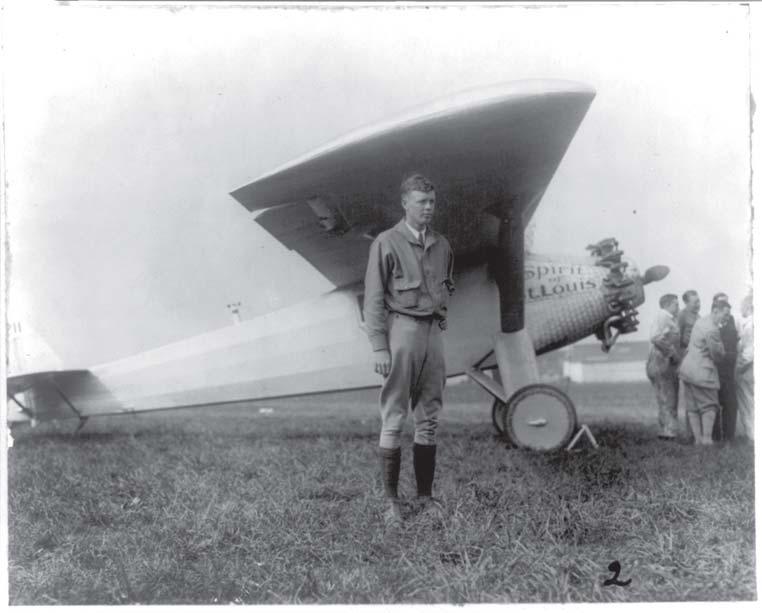
ing and biking trails so “we would like assurances that the sweeping views of the runways we have now will not be blocked by tall buildings or hangars.”
Community input includes desires for the new development to employ neighborhood residents and for the event center be available for general public rentals.
stands the community perspectives, van Rooyen speaks reverently about the history that’s graced Lunken’s airfield over the century. Charles Lindbergh landed the Spirit of St. Louis here in 1927, less than three months after he took his single-engine plane across the Atlantic Ocean. Amelia Earhart touched down two years later in her fire-engine red Lockheed Vega, appearing in the first-ever Women’s Air Derby. Jimmy Doolittle, Neil Armstrong, and Howard Hughes have graced its runways. Air Force One
has dropped in a few times.
This storied past will be celebrated in a small museum that van Rooyen will house in the terminal, improving on one that was there before. In its prime, the terminal provided a roof over not only travelers and a museum but also offices for several flight schools, a pilot accessories shop, a mortgage company, a police substation, and even a dentist’s office. It was a bustling place.
It looks tired and faded these days. Your ears note the silence, and your nose picks up a faint odor of jet fuel mixed with a stale must. But your eyes behold two iconic features: the William Harry Gothard murals and the bright yellow two-seat Aeronca C-3 Master (labeled at the time “the flying bathtub”) that’s suspended from the ceiling.
The murals will stay, but the vintage airplane will need to find a new home.
“I really don’t want a 1,000-pound
Lunken was Cincinnati’s original commercial airport and has hosted visits by Charles Lindbergh (above), Amelia Earhart, and Air Force One
structure hanging there,” says van Rooyen with a nervous laugh. “But we’ll make sure it’s saved. That’s a part of our discussions with the city.”
He’s also committing to preserve the period iron guardrail garnished with embossed rosettes that lines the upper-level balcony. That will lead to 36 hotel rooms dominating the new addition on the terminal’s back side facing the runway. The museum is also planned for the second floor. “We want there to be a feel to the lobby, a volume of space that makes you feel like you’re walking back in time to the days when The Beatles came here,” he says of the Fab Four’s 1964 visit.
The Sky Galley restaurant, which was to patrons’ left as they entered the terminal from Wilmer Avenue, may be relocated, van Rooyen says. “We want to be sure all the major points in the development have easy sight lines to the field, so relocating the restaurant to the right might be a better position,” he says. “More work to do, though, on that.”
And it won’t be called The Sky Galley. There are bigger fish to fry than settling on a restaurant name or theme right now, but van Rooyen is looking to create an establishment that’s less like a national chain and more like Coppin’s at his Hotel Covington. He says the new dining venture might have two concepts, one higher end for the dinner crowd and the other more casual for lunch. There might be a walk-up counter to serve patrons on the bike trail or families who want to watch the planes and eat a sandwich al fresco.
Similarly, van Rooyen envisions the new boutique hotel and event center as a prime space. He plans to use construction materials and a color pattern that closely aligns to the existing terminal, with two-story
wings connected at 90-degree angles to the existing terminal and ending at the taxiway fence line. A courtyard suitable for outdoor events will separate the wings. Towering above it all will be the original Lunken Airport tower with the painted black brick just outside its window, which will be converted into a lofted presidential suite with a bedroom on the top level and living space below. “It will have the commanding view of the field,” he says.
Like his vision of a restaurant similar to Coppin’s, van Rooyen envisions a hotel that has the features, service, and polish of Hotel Covington. He mentions two rock stars, Joan Jett and Billy Idol, who stayed in Covington when they performed at Riverbend on May 21 and suggests future entertainers would value the convenience of Lunken, especially if they have a
private jet parked on the tarmac. “We want to exceed what we’ve done at the Hotel Covington,” he says. “We want a luxury footprint that provides an experiential stay, infused with the history of the field and of aviation.”
Everyone hopes that van Rooyen’s investment will encourage further development in the east end, especially along Kellogg Avenue. There’s little inviting scenery between the airport and Rivertowne Marina as motorists enter the city from the east. This Lunken project could be a catalyst for wider development, looking to recent housing construction along Eastern Avenue as evidence that the east side can be popular again.
“Just one caveat to that,” says van Rooyen, repeating with a knowing smile. “FEMA wants you to build up because it’s a flood plain, but the FAA wants you to build down.”
Developer Gus van Rooyen hopes to expand Lunken’s terminal to include a boutique hotel and event space. “We want a luxury footprint that provides an experiential stay, infused with the history of the field and of aviation.”

IS GOOD FOR THE COMMUNITY AND OFTEN GOOD FOR BUSINESS, TOO.
BY ELIZABETH MILLER WOOD
In 2016, JBM Packaging was a 40-year-old family business with a problem: It needed more workers. Like many manufacturing employers, JBM’s laborers were aging out of the workforce and the company needed fresh hands to operate the labor-intensive mechanics of its paper-packaging products.
As recruitment efforts ensued, however, it didn’t take long for second-generation owner Marcus Sheanshang to realize that the company’s primary strategy—hiring non-college-bound students out of high school—was not a viable solution. “We were completely disappointed,” he recalls, adding that no matter how much pizza and bus transportation they provided they “couldn’t find kids who wanted to work.”
Then, through Crossroads Church, Sheanshang, who serves as president and CEO of JBM, caught wind of ministry efforts inside a local correctional institution. He reached out to an organizer of the ministry and realized there was a large population of people getting out of prison who’d be looking for work but would also face prejudiced barriers to employment.
At first, Sheanshang notes, “We were really trying to answer a strategic problem we

had.” But as JBM began pursuing the possibility of hiring formerly incarcerated individuals, he realized the opportunity was far greater than just filling shifts. It became a chance to change lives and build a better business.
Sheanshang and his team did their research. They consulted with Dan Meyer at Nehemiah Manufacturing, the region’s first and largest second-chance employer, which opened in 2009 and has grown year-over-year into a business with $150 million in annual revenue. Of Nehemiah’s 300 team members, roughly 80 percent are second-chance employees; most are formerly incarcerated, but they also include those recovering from substance abuse, those emerging from homelessness, and survivors of human trafficking.
JBM set out to implement its own second-chance program, which Sheanshang decided would not include those who’d been convicted of sex crimes, crimes against women or children, or crimes involving violence. The company’s hiring niche ended up focusing on those with drug-related criminal offenses, which included tangential crimes like burglary or theft largely driven by money to buy drugs.
Despite their research and good intentions, JBM hit some hiccups out of the gate. “We were probably not well versed as how to handle some of the situations,” Sheanshang admits candidly.
Initially, company leadership limited intel about second-chance employees to those in the highest echelons of management, not wanting new hires to be judged unfairly by floor managers or other team members. The staff didn’t appreciate that decision. “They felt left out,” Sheanshang says, acknowledging their perspective. “I would want to know, too.”
The company then embraced a more transparent approach, clueing all team members into the second-chance program while still not explicitly “advertising” which employees were hired after serving a sentence.
In 2019, a few years into the program’s early iterations, JBM also changed its program terminology from second chance to fair chance, feeling that “second chance” sounded too much like “second-class citizen,” Sheanshang says. “We wanted to put a more positive label on it.”
The program took yet another pivotal turning point when an employee placed a comment into the company’s anonymous comment box: “I don’t want to work with these people.” JBM had a decision to make: Would they risk losing current employees by developing this fair-chance program? Sheanshang’s answer was clear. “This is who we are now,” he says. “If you don’t want to work with ‘these fairchance people,’ then this might not be the place for you any more. It was the proverbial stake in the ground.”
Today, JBM has 173 employees, 63 of whom are in the fair-chance program. That’s 39 percent of its workforce. “It’s helping the business without a doubt,” says Sheanshang.
Because of its fair-chance program, JBM was able to launch a new labor-intensive product line that required minimal training. It was an ideal opportunity to vet second-chance employees quickly without sinking multiple months of training into staffers who weren’t ready to commit to ongoing employment.
JBM has even begun offering employment within correctional facilities. At the Lebanon Correctional Institute, JBM has placed three pieces of manufacturing equipment on which inmates can learn trade skills that will translate

Tyler Meenach and Recovery Friendly Hamilton County, founded in 2022, serve as a bridge between the business and rehabilitation worlds.
to employment at JBM once they’re out. Best of all, the inmates earn an income in the process. “We just hired a guy three weeks ago who left prison with $4,000,” says Sheanshang.
or second-chance employer can be an enormous differentiator when competing for new business. All else being equal in terms of products and prices, JBM can tell prospective clients, “When you send us work, you’re helping people get back on their feet,” which really resonates with certain prospects, Sheanshang says. “Even if they don’t buy from you, they’re interested. I think it gives us another bite out of the apple when trying to win new work.”
In some cases, he says, clients are happy to pay a premium to partner with a purpose-driven company. That approach also spurs elevated levels of employee loyalty, especially among the more educated and upper-management positions. Sheanshang recognizes that many of his highest-level employees have ample opportunities to work elsewhere but stay with JBM because “they feel good about what they do.”
“Millennials and Gen Z are deeply purpose driven,” says Kristen Schumacher, chief marketing officer of Nehemiah Manufacturing and a Millennial herself. “They want more than a job. They want to be part of something meaningful. Our mission to build brands, create jobs, and change lives resonates strongly with them.”
Schumacher says it’s valuable insight for employers looking to fill their talent pipeline to know that current and upcoming generations want to work in mission-oriented environments. These companies not only provide employees with purpose, but they also build employee loyalty.
Employee loyalty at JBM is also

“WITHOUT PROFIT, THERE IS NO PURPOSE,” SAYS JBM PACKAGING CEO MARCUS SHEANSHANG ABOUT HIS INVESTMENT IN SECONDCHANCE HIRING, WHICH SUPPORTS BUSINESS GROWTH AND ALLOWS THEM TO HELP MORE PEOPLE.
built from an intentional strategy to promote from within, including those who enter the company through the fair-chance program. Amanda Hall is a fair-chance employee hired by JBM one month after her prison release in 2019. She is now JBM’s talent acquisition and training specialist and has
personally trained Sheanshang’s own children in equipment operations within the family business.
Success stories like Hall’s are the fruit of the “people pipeline” that addressed JBM’s initial pain point nine years ago, and it continues to be a viable personnel strategy going forward as the company grows. “You need to have a people strategy,” Sheanshang says. “Where would we be without those people?”
Like most new business initiatives, second-chance employment programs come with front-end costs and risks. It’s not a journey to embark upon lightly, or alone, without a network of support services.
JBM employs two full-time life coaches who meet with each fair-chance employee for 30 minutes each week, a significant investment of the company’s time and resources that Sheanshang insists is crucial to the program’s success. Life coach meetings are mandatory for JBM fair-chance employees for the first six
months of their employment, during which the professionals deliver a more comprehensive level of support than what a typical HR department can offer. People re-entering society after incarceration often experience unstable or unsafe housing, unreliable transportation, child support issues, or medical snags—any of which may impede their ability to maintain steady employment. “They’re a flat tire away from their world going out of control,” says Sheanshang.
Because a full-time job is often the glue that holds together all the other pieces of a fragile life, JBM’s life coaches help connect people to the support services they need to stabilize factors outside of work. “They are Switzerland, a third party, a safe conversation,” says Sheanshang, who also personally meets with each employee at the 60-day mark of his or her employment.
JBM’s support network includes social services programs like CityLink, Financial Peace programs, felony-friendly landlords, and Wheels, a ministry that repairs donated vehicles

and gives them to those who qualify. Wheels has donated 45 cars to JBM employees, including Hall.
All that said, even with the best intentions and most strategic supports in place, JBM’s fair-chance program doesn’t guaranteed perfection. People leave, and some relapse. It’s unrealistic to expect that every employee who was given a second chance will stick around to fulfill the investment put into them; JBM’s fair-chance turnover is 21 percent, but Sheanshang is content with that figure. “Not everybody is ready for us,” he says.
JBM’s vision is long and nuanced, and ultimately it’s bigger than the immediate bottom line—though, as JBM has seen, having an empathy-centered business strategy has paid off both in company culture and on profit spreadsheets. In a business that seeks to give people a second chance for the lowest points in their lives, the more the business grows, the more people they can help. “Without profit, there is no purpose,” says Sheanshang. “This is a beautiful marriage of the two.”
BUSINESSES THAT ARE interested in the mission-minded approach of a second-chance or fair-chance program but don’t have the infrastructure, resources, or operations needed

to employ formerly incarcerated individuals will find several local organizations willing to assist. Cincinnati Works coordinates an alliance of businesses, human service agencies, faithbased ministries, and justice groups under the Beacon of Hope banner. The program works with employers and individuals alike to maximize the chances for successful employment.
The Recovery Friendly Hamilton County (RFHC), founded in 2022, serves as a bridge between the business and recovery worlds. According to the National Survey on Drug Use and Health, approximately 23 million Americans are in substance abuse recovery, and the National Institute of Occupational Safety and Health says 60 percent of those are employed in the workforce.
RFHC Coordinator Tyler Meenach, who worked in correctional rehabilitation for a decade prior to helping launch RFHC, says the vision was to
establish a framework to coordinate with businesses to help them effectively manage substance-use disorder among their personnel.
A 2022 survey conducted by ForsMarsh found that people are more likely to feel comfortable disclosing substance use problems or asking for help with a substance use disorder when their manager has directly stated that employees can share those concerns. People in recovery are also more likely to take action when they notice a coworker may be struggling with substance use disorder.
By creating RFHC-guided work-
JBM Packaging practices what it preaches in fairchance employment: (opposite page) Amanda, a talent acquisition specialist, checks in with new team member Chad; (far left) Maranda, HR generalist, onboards all incoming team members; (left) Donna works with Sarah to onboard as a machine operator at JBM Packaging; and (below) Marcus checks in with Christen.

A number of manufacturing employers are having difficulty replacing laborers aging out of the workforce, and some pursue “second chance” hiring of those released from prison who face prejudiced barriers to employment. JBM Packaging, which calls its program “fair chance” hiring, has seen employee retention and business growth stabilize after embracing it.
Some of JBM’s clients are happy to pay a premium to partner with a purpose-driven company, says owner Marcus Sheanshang. Second-chance hiring also spurs elevated levels of employee loyalty, especially among upper-management positions and younger purpose-driven staff.
Businesses interested in second-chance programs but without the infrastructure or resources needed to employ formerly incarcerated individuals can get training and support from Cincinnati Works and Recovery Friendly Hamilton County.
places that allow employees to discuss and disclose substance use issues in safe environments, businesses create cultures that reduce stigmas and open avenues for help and continued recovery. Among RFHC workplaces, only 15 percent reported that stigma against individuals recovering from substance use disorder exists in their own workplace culture; 65 percent of employers noticed a decline in stigma after certification.
To become a RFHC Workplace, employers must engage in a certification process that includes training on recovery-friendly practices, a formal declaration of their RFHC status to their employees (often through a company-wide email), orientation training, and a visible list of RFHC resources in an accessible location within the company. Business perks of certification include cost-saving connections in the form of reimbursement programs such as recovery training or drug testing, life-saving first-aid supplies, optional avenues for recruitment, and public recognition for the compa-
RECOVERY FRIENDLY HAMILTON COUNTY HAS TRAINED WORKPLACES TO DISCUSS AND DISCLOSE SUBSTANCE USE ISSUES IN SAFE ENVIRONMENTS, REDUCING STIGMAS AND OPENING AVENUES FOR HELP AND CONTINUED RECOVERY.
ny for its recovery-friendly orientation. Employees of RFHC Workplaces are also provided a proprietary 24/7 helpline.
Certification is free, and the benefits to employees and employers alike are notable. “What I hear from all of my colleagues and what we’ve seen internally with some of our own survey data is employers are reporting that


there’s an improved morale among their employee base,” says Meenach. “There’s an improvement not only in morale, but in retention.”
Currently, 66 local employers are certified through RFHC. The program requires a yearly renewal procedure and has thus far secured a 100 percent retention rate, not including two businesses that closed since certification. Businesses range from mom-and-pop shops to large regional employers like Gorilla Glue, Messer Construction, and the City of Cincinnati.
Nationally, the recovery-friendly workplace paradigm was first introduced in 2018 in New Hampshire under then-Gov. Chris Sununu. The model has since been replicated more than 30 times across the country, but many are operated as nonprofits or through state governments; RFHC is one of the few maintained by a local government. “We’re often kind of held as a shining example of how to
do this locally,” Meenach says. “We’ve been able to do things larger entities haven’t been able to do successfully because we have such a keen grasp on everything within our county.”
Like JBM, employers who implement programs that give second chances—whether for felonies or substance use—have much to gain from a business perspective, not just a humanistic one. “Most businesses are contending with substance use disorder in one way or another, whether they realize it or not,” says Meenach. Industries such as construction, food and beverage, and manufacturing report the highest percentages of recovery populations and oftten deal with decreased productivity, absenteeism, and turnover.
“An employer who fails to address that sizeable population, again, is going to lose a lot economically when it comes to turnover,” says Meenach. “It’s about recognizing that recovery over substance use disorder is a
strength. These are people who have really gone to battle with their brains on biology, their naysayers, their demons, and they’ve come out victorious.”
When employers embrace the profound effect they can have on an employee’s life and create infrastructures to support those who are most valuable, it creates a healthier, more reliable business culture. By intervening or providing resources to those in recovery, employers may also be in a position to save lives.
“I think what a lot of employers don’t realize is how many cards they hold,” says Meenach. “There’s a lot of research indicating that employer-motivated intervention or employer-initiated intervention is more effective than family intervention, and that really makes sense if you think about it from a behavioral psychology perspective. An employer is giving that person the funding to essentially live their life the way that they want to life their life, right? You’ve got their health insurance. You’ve got their paycheck. You’ve got their ability to feed their family in your hands.”
In the big picture, recovery-friendly workplaces can even influence micro and macro economies. “I think it’s safe to reason that with such a significant number of people in this country identifying as being in recovery, it follows logically that being a recovery-friendly employer could result in better outcomes for employers and better consumer perceptions,” says Meenach. “It’s good for business, and it’s of course the right thing to do for employees. I always like to say that recovering citizens are resourceful, resilient, and ready to work.”
It’s just up to employers to give them a chance.
Donnie (opposite page) is a recent graduate of JBM’s Better Lives program and is now a press assistant, while Randall (left) has been working with Better Lives coaches in his new job as warehouse associate.

MAKING A SUCCESSFUL EXIT THROUGH PREPARATION, MARKET AWARENESS, AND CONNECTIONS.
BY SARAH M. MULLINS
For most small business owners, selling their company represents the largest financial transaction of their lifetime—often worth more than their home, car, and other investments combined. Yet while we readily know our home’s market value and can sell it relatively quickly, the vast majority of small business owners have little idea what their business is worth or how to navigate the complexities of selling it.
According to Brit Karel, cofounder of SMB, a marketplace for selling businesses, 80 percent of small businesses never successfully sell, with many owners simply shutting down because they don’t know where to start or can’t find buyers. This challenge is particularly relevant in Cincinnati, where a strong entrepreneurial ecosystem has created thousands of family-owned and privately-held businesses across industries from manufacturing to home services.
As the baby boomer generation reaches retirement age and begins retiring—what experts call the “silver tsunami”—more area business owners than ever are facing exit decisions. The region’s business
community has responded by developing robust support networks, from UC’s Goering Center for Family and Private Business to entrepreneurship-through-acquisition groups that connect local buyers with local sellers. The difference between those who exit successfully and those who don’t often comes down to preparation, realistic expectations, and strategic thinking about the transition years before it happens.
Industry experts who have sold a business, supported entrepreneurs through the sale process, or bought a business themselves agree on one key point: It’s never too early to start thinking about your exit strategy and understanding your business’s value. The most successful business sales happen when owners think strategically about their exit years in advance rather than make reactive decisions when offers appear or personal circumstances force a quick sale.
As Karel puts it, it’s never too early, and just like retirement you should have multiple options. She says too many business owners get “stuck in the weeds”of running the business day to day and fail to take time to ensure they’ll be able to exit successfully and retire from all their hard work. While there’s no single playbook to follow, there are generally situations to consider and red flags to manage when preparing your business for sale.
DAVE KNOX, EXECUtive director of Blue North, one of Kentucky’s six innovation hubs, says identifying your “why” is the first question business owners must ask themselves before considering a sale. Are you looking to maximize financial return, preserve your legacy, or maintain the community you’ve built? Consider whether you want to sell to employees (ESOP), family members, local entrepreneurs, or private equity

firms. Each path has different implications for price, transition, and long-term impact.
Knox, co-founder of The Brandery, Cincinnati’s seed stage startup accelerator, first became aware of the term entrepreneurship through acquisition (ETA) when Northern Kentucky lost three locally-owned hardware stores to an out-of-town owner. When they went up for sale, local entrepreneurs, including Knox, were interested, but a national franchisee from Chicago ultimately bought them all. “Yes, the hardware stores are still there, but we’ve lost our local tie,” he says. “National private equity firms come in and don’t necessarily care about your community.”
Local businesses are more than
just businesses—they’re sponsors of local sports teams, they know customers by name, and they reinvest profits locally. That’s why Knox says the fundamental question every business owner must ask themselves is: What’s your goal for your business’s next chapter? Is it to maximize profit by selling to the highest bidder or to preserve the community impact you and your business have built?
Carol Butler, president of the Goering Center for Family and Private Business, says answering that question can be tough, but you have mutliple options. Selling to employees and selling to family are two of the most common situations the Goering Center helps owners navigate. “Cincinnati is the third largest ESOP city in the country per capita,”
Dave Knox says business owners must determine a goal before deciding to sell: Do you want to maximize profit or preserve your company’s community impact?
Brit Karel (left) of SMB, a marketplace for selling businesses, and Carol Butler (right) of UC’s Goering Center for Family and Private Business say company owners should start the sales planning process early.

she says. “That says a lot about people who want to leave the legacy to their employees.”
Butler cites Messer Construction and The Party Source as examples of local ESOPs. A consideration for that set-up, she says, is that opening your books to employees may not be something a business owner wants to do.
Once you’ve clarified your motivations and ideal buyer, the next critical step is understanding what your business is actually worth in today’s market. Understanding true market value is essential, as many business owners overestimate their company’s worth similar to homeowners believing their property is worth more than the market is willing to pay.
Knox advises business owners to research industry valuation as their starting point. “There’s so much publicly available information,” he says.
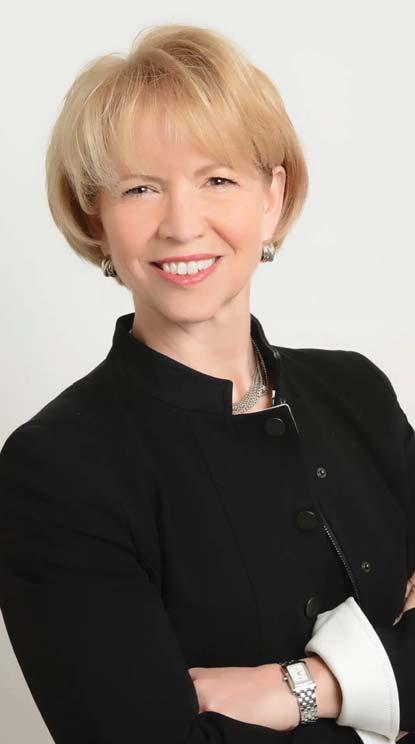
“Just starting with a benchmark within your industry educates you about what you have and how you approach it.”
Be prepared for a reality check in the valuation process, says Butler, who recommends getting a business valuation every two years to keep a pulse on the value regardless of sale plans. She describes a business owner who shared that his valuation was half of what he expected, but he discovered what he needed to work on in order to attain the value at which he wanted to sell. “Just like any other key decision we make in business or in life, knowing the sense of value is incredibly important,” she says, “so you know where your value adders are, what you need to do to grow the business, and what is detracting from the value of your business.”
One red flag that could impact a
company’s valuation is the weight the business has in one or a small number of contracts. For example, if 80 percent of your business is from one customer, the company’s future is at risk if the contract doesn’t renew.
Get ahead of determining value by researching comparable sales in your industry and understanding the current market. Butler says that hiring a professional is important to conduct a thorough valuation and to be prepared for reality checks on pricing expectations as well as understanding what buyers in your market are actually seeking.
Home services represent a particularly hot business sector, for instance, though Knox notes that trends can emerge quickly and are often driven by private equity interest. Regardless of the industry, businesses with repeatable revenue streams, consistent
customers and contracts, and steady subscriptions wil be consistently attractive to buyers who value predictable cash flow.
of your sale by separating personal and business expenses, organizing all financial documentation, and obtaining a professional business valuation. It’s common for small businesses to have a personal car that’s being treated as a business expense, for instance, which isn’t necessarily bad practice but can complicate the sale process.
Buyers need to see clear “seller discretionary earnings,” the cash flow a new owner can expect from the business if they took over. Knox recommends investing in a quality-of-earnings analysis even before starting the sale process. “If somebody’s books are in really good shape, the buyer is going to have faith that the rest of the business is in equally good shape,” he says.
Work with qualified accountants to ensure your books are clean and transparent. Knox says consistent revenue patterns are more attractive to buyers than revenue that doesn’t follow a pattern. “A lot of businesses can be lumpy because of contracts,” he says. “But somebody looking at a business that in 2023 was $6 million in revenue and then in 2024 it was down to $4.5 million and then the next year was up to $7 million, they don’t know what to do with that information versus one year was $4 million, then $4.25 million, then $4.5 million. Being able to see that nice straight line is a really good thing.”
One of the biggest reasons a business might be a tough sell is that the owner is a significant part of its success. So the experts recommend making your business transferable by reducing reliance on your personal involvement. Document processes, develop your management team, and ensure the business can operate without you. “Buyers don’t want to buy a job, they want to buy a business,” says Karel. “Buyers want businesses that cooperate with a great operator in place. And getting that person to understand they need to slowly get themselves less intertwined with the business is huge.”
Operational risks to watch out for can also include specific certifications or required union memberships that can narrow down the buyer pool. Also address potential red flags like customer concentration, legal issues, and expiring leases.
Current employees are another area that must be ironed out. Buyers are buying revenue, but they’re also
Buyers have their own set of priorities when assessing a potential acquisition and how they’d manage the new business on day one. Steve Bennett made the leap from corporate consulting to business ownership when he bought Pilot Lumber, a building materials company in Northern Kentucky, which he’s since sold. Bennett spent his early career working on process improvement and large-scale supplier relationships at Accenture’s Strategy Group. After roles at a software startup and leading organizational change at Cengage Learning, he decided to pursue entrepreneurship through acquisition (ETA).
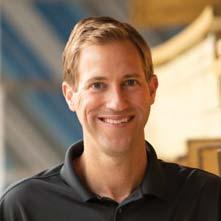
What motivated you to pursue acquisition rather than starting a new business from scratch? I was drawn to ETA because it offered me a faster path to business ownership with a real, proven business and allowed me to apply skills I’d developed in the corporate world in a way where I could grow and operate for myself. I also have a family, so it allowed me to have income on the very first day and somewhat lower risk than starting a new business from scratch.
How did you find your first acquisition, and what was your biggest surprise or challenge? I found the Pilot Lumber deal through a local network and a broker via relationships I had grown previously. What drew me in was its long history of profitability, its loyal customer base, and opportunities I saw to grow the business. I moved forward because the fundamentals were strong, even though I knew nothing about lumber. The biggest challenges I understood going in, but honestly didn’t fully grasp before purchasing, were how relationship-driven the day-to-day operations were, how competitive and how much purchasing power helps in the industry, how hard it was to hire good employees, and how important it is to manage cash flows in an asset-heavy business.
How do you approach the transition period after acquiring a business? My goal for the first year was to understand the business and listen to employees. I spent the early weeks learning the business on the ground, building relationships, and making it clear that I wasn’t there to make sweeping changes. Retaining key employees was crucial, so I had a lot of one-on-one conversations and worked to understand what motivated them. I also made sure I could do every job for every employee—though they never let me drive or run a forklift—to show my dedication to the business and to understand what every role entailed.
What advice would you give someone considering his or her first acquisition? Don’t underestimate the emotional component—for you and for the seller—and have people in your corner to get you through it. I would also make sure you’re purchasing something you will enjoy. It’s something you’ll end up thinking about 24/7. —S.M.M.
Between the number of Baby Boomers looking to retire and increased activity from private equity, lots of business owners are considering selling these days. The keys to exiting successfully often come down to preparation, realistic expectations, and strategic thinking about the transition years before it happens.
FIGURING IT OUT
Business owners must determine the “why” before any other apsect of selling. Do they want to maximize financial return, preserve their legacy, or maintain the community they’ve built? The answer will help them decide if they should sell to employees, family members, local entrepreneurs, or private equity firms.
BARRIERS TO SELLING
There are many reasons a business could be tough to sell: inconsistent annual revenue, income concentration in one or two contracts, and the current owner being essential to the company’s success. Those issues can be managed with enough preparation before selling.
buying a team that helps that business run. “I’ve seen children of the previous owner who are employed in the business and the family decides not to sell it or pass it along to them and there’s bitterness, which can be really messy,” says Knox. “There can also be longterm employees who feel they should have had an opportunity to buy.”
BUTLER AND KNOX RECOM-
mend that business owners not go at it alone in the sales process. Build relationships with key advisors, including business attorneys, accountants, tax specialists, and potentially business brokers or merger and acquisition experts. Each plays a crucial role in maximizing value and ensuring a smooth transaction.
Butler emphasizes the need for objective analysis of the business. “We think it’s really important to have a board of advisors or a board of directors,” she says. “For a business going through a transition, it’s wonderful to have a group of independent advisors who can really help you through that process. When you’re so close to the business, it’s often hard to work on the business.”
not going to get that if you’re relying only on the people who are cold-calling you.”
Engage with local groups like Cincy ETA or other business networks to meet potential buyers before you’re ready to sell. You’ll have a better opportunity to find buyers who align with your values and vision for the business’s future and learn from others who have gone through the sales process.
Beyond traditional networking, digital platforms like SMB are creating new ways to build these relationships—think Zillow for businesses. The goal is to make business transactions more transparent and accessible. “We
“A GROUP OF INDEPENDENT ADVISORS CAN HELP YOU THROUGH THE SELLING PROCESS. WHEN YOU’RE SO CLOSE TO THE BUSINESS, IT’S OFTEN HARD TO WORK ON THE BUSINESS.”
Start building connections in the business community early, but be strategic about confidentiality to avoid awkward conversations with employees and your key contracts and vendors. As ETA activity has heated up and more private equity has entered the space, Knox says he personally knows business owners who get multiple cold calls a week asking if they’re looking to sell their business. “The thing I’d love to see is more business owners thinking about selling in two, three, or four years getting involved today,” he says. “Meet the people who are in this community. You’re
can list any business, but really our sweet spot is the under $1 million or $2 million businesses, which are completely underserved,” says Karel.
Like Zillow, if you’re looking for something within a 30-mile range of your home, you can narrow down your search. You can also search for not-yet-listed businesses, and SMB can help owners or buyers find hidden opportunities. “Most of these owners have no idea that a possible exit is even possible unless they’re in industries like HVAC, laundromats, and car washes that get bombarded from private equity firms,” says Karel. “We reach out to these owners on their behalf and make those connections.”






























50 Years of Excellence. A Legacy of Success.


FOR 50 YEARS!

MEET CELEBRITY BARTENDERS ENJOY LIVE STAGE DEMOS MINGLE IN THE TASTING LOUNGES
“A CELEBRATION OF SPIRITS AND COCKTAILS”

WHEN August 21, 2025
WHERE IN VIP 5:30pm
GENERAL ADMISSION 6-9pm
A PORTION OF THE PROCEEDS BENEFIT

SUSTAINABILITY PARTNER

SPONSORED BY














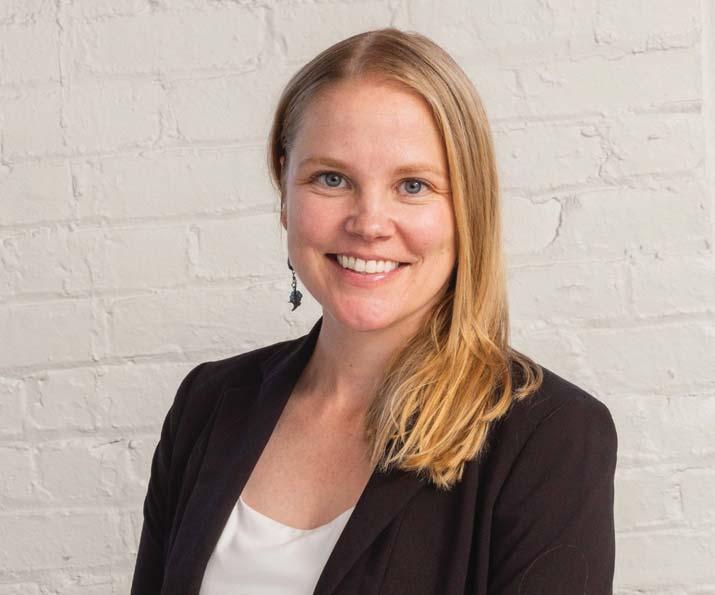
PRESIDENT
URBAN SITES
HOW DOES THE NEW POSITION OF PRESIDENT AFFECT THE COMPANY’S OPERATIONS?
This new President role introduces additional bandwidth and perspective to accelerate our work and sharpen our longterm vision. I look forward to building on the strong foundation we’ve laid, leading day-today operations, and guiding the company into its next phase.
HOW DOES NEIGHBORHOOD-BASED DEVELOPMENT SERVE UNIQUE COMMUNITY NEEDS? It begins with understanding the specific goals, needs, and challenges of a community. We seek to amplify what’s already there while still providing a unique experience. That means looking
ASK ME ABOUT
How the company creates unique living experiences and vibrant communities.
at factors like walkability, access to green space, the commercial footprint, and how a block connects to its surroundings. We work hard to create synergy between residential and commercial uses, placing the right businesses in the right locations to encourage longer visits and meaningful engagement
from residents and visitors alike. We’ve also expanded into affordable housing, which was a deliberate move to give us the flexibility to support a broader range of housing needs.
WHAT FACTORS SHOULD BE CONSIDERED IN PRESERVING A NEIGHBORHOOD’S CHARACTER? It starts with understanding
PRESIDENT AND CEO
CAROL ANNE AND RALPH V. HAILE JR. FOUNDATION
ASK ME ABOUT
Relocating the foundation’s headquarters to Covington.
what defines the neighborhood. We listen to what neighbors value most and do our best to reflect those values in our work. Increasing density and adding housing opportunities can be an important tool to support local businesses and preserve a neighborhood’s the spirit.
–ELIZABETH MILLER WOOD
HOW HAS YOUR BACKGROUND PREPARED YOU FOR THIS NEW LEADERSHIP ROLE? In a lot of ways, everything I’ve done up to this point was preparing me for this role. At Ohio Alleycat Rescue, I had the honor of leading a team deeply committed to saving lives. Before that, I spent a decade on City Council, including as Council President Pro Tem, where I worked to make Cincinnati a more inclusive, equitable, and welcoming city. At SPCA Cincinnati, I get to combine both of those worlds: practical leadership and public service, strategic planning and compassion.
HOW DOES ANIMAL WELFARE IMPACT THE COMMUNITY AT LARGE? Animal welfare isn’t a side issue, it’s a community issue. Shelters are often a reflection of the community around them. A shelter that’s overcrowded, under-re-

sourced, and struggling to meet basic needs is rarely the root of the problem—it’s the symptom. To fix that we have to work upstream—that means housing stability, access to care, behavioral support, and programs that meet people where they are.
HOW DO YOU HOPE TO MAINTAIN AND ADVANCE THE MISSION OF SPCA CINCINNATI? This organization has been saving lives since 1873. But we’re not here just to care for animals—we’re here to transform what animal welfare can look like. We’re launching new behavior and enrichment initiatives to better support long-term residents. We’re exploring creative adoption and foster models. And we’re investing in our people— our staff, volunteers, fosters, and adopters—because they are the heartbeat of this mission. Most importantly, we’re going to listen, because this work is about building a more compassionate Cincinnati. –E.M.W.
WHAT WAS BEHIND THIS RELOCATION? It’s a true homecoming. We’re honoring our past by moving to the very location where Mrs. Haile’s father, Clifford Homan, guided the family business, Peoples-Liberty Bank and Trust, through various economic cycles. Ralph Haile was committed to the city of Covington, and he and Mrs. Haile established the foundation to serve as a vehicle to continue
PRESIDENT AND CEO
SPCA CINCINNATI
ASK ME ABOUT
Why I’m passionate about animal welfare and how animals help shape our community.
their work in giving back and supporting our community.
HOW WILL THE SPACE BE RENOVATED TO EQUIP IT FOR YOUR FUTURE USE? We’ll occupy the entire second floor at the corner of Pike and Madison streets, which Covington designated as Ralph Haile Square shortly before he passed away in 2006. The space is currently being renovated to accommodate
the needs of the foundation’s day-today operations while respecting the building’s historical significance. The most significant and heartwarming change will be to Mr. Haile’s former office: It’s being converted into the foundation’s new board room. It’s serendipity.
HOW WILL THIS NEW LOCATION IMPACT THE FOUNDATION’S MISSION? The
Haile Foundation has been and will continue to be deeply committed to enhancing the vitality of our communities across the tristate region through strategic investments in arts and culture, education, civic and community, and human services. Moving to Covington, or anywhere for that matter, will not change our resolve and commitment to serving our community.
–E.M.W.

July through September is peak outdoor season, from neighborhood events to big regional blowouts. Here are a few festivals to check out.
–JOHN FOX

Watch, tour, and ride vintage aircraft at Lunken Airport Days on August 30-31.


Montgomery hosts its annual Bastille Day celebration on July 19 with live music, food, drinks, and kids activities. Launched in 1989, bicentennial of the original Bastille storming in Paris, this event raises funds for the community’s sister city programs with Neuilly-Plaisance, France.
Come down to the riverfront on August 9 and watch Red Bull Flugtag participants try to get airborne in homemade flying machines. Spoiler alert: They never do.
Lunken Airport Days on August 30-31 feature historic aircraft, including a WWII B-17, as well as airplane tours and rides, live music, and a classic car show.
The annual Ohio Renaissance Festival returns to Waynesville August 30 through October 26. Come grab a huge turkey leg for nourishment and take in sword fights, jousting, and vintage crafters.

PHOTOGRAPHS BY (FLUGTAG) GRANT MOXLEY / (FALL FESTIVAL) KEITH NELTNER / PHOTOGRAPHS COURTESY OF (BASTILLE DAY) THE CITY OF MONTGOMERY / (BLOOMS & BERRIES) BLOOMS AND BERRIES/ (COUNTRY PUMPKINS) COUNTRY PUMPKINS / (RENAISSANCE FESTIVAL) OHIO RENAISSANCE FESTIVAL/ CHECKMATE PHOTOS / (OKTOBERFEST) RHINE MEDIA




After a successful first year on the riverfront in 2024, Oktoberfest Zinzinnati returns to Sawyer Point and Yateman’s Cove September 18-21, including Thursday evening hours. The nation’s largest Oktoberfest hit a home run with last year’s Munich-style festival tents.
Get in the harvest spirit at various fall festivals across the region, including Country Pumpkins Fall Festival September 7-October 31 in Dry Ridge, Fall on the Farm September 13-October 31 at Blooms & Berries in Loveland, and Neltner’s Farm Fall Fest September 27-October 26 in Melbourne, Kentucky.



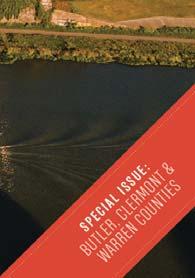






















The Howe Center for Writing Excellence at Miami University ensures that all students, regardless of their major, become effective communicators and problem solvers. Thanks to the Howe Center’s innovative programming and support for both faculty and students, a Miami education shapes exceptional communicators and leaders in every field.
